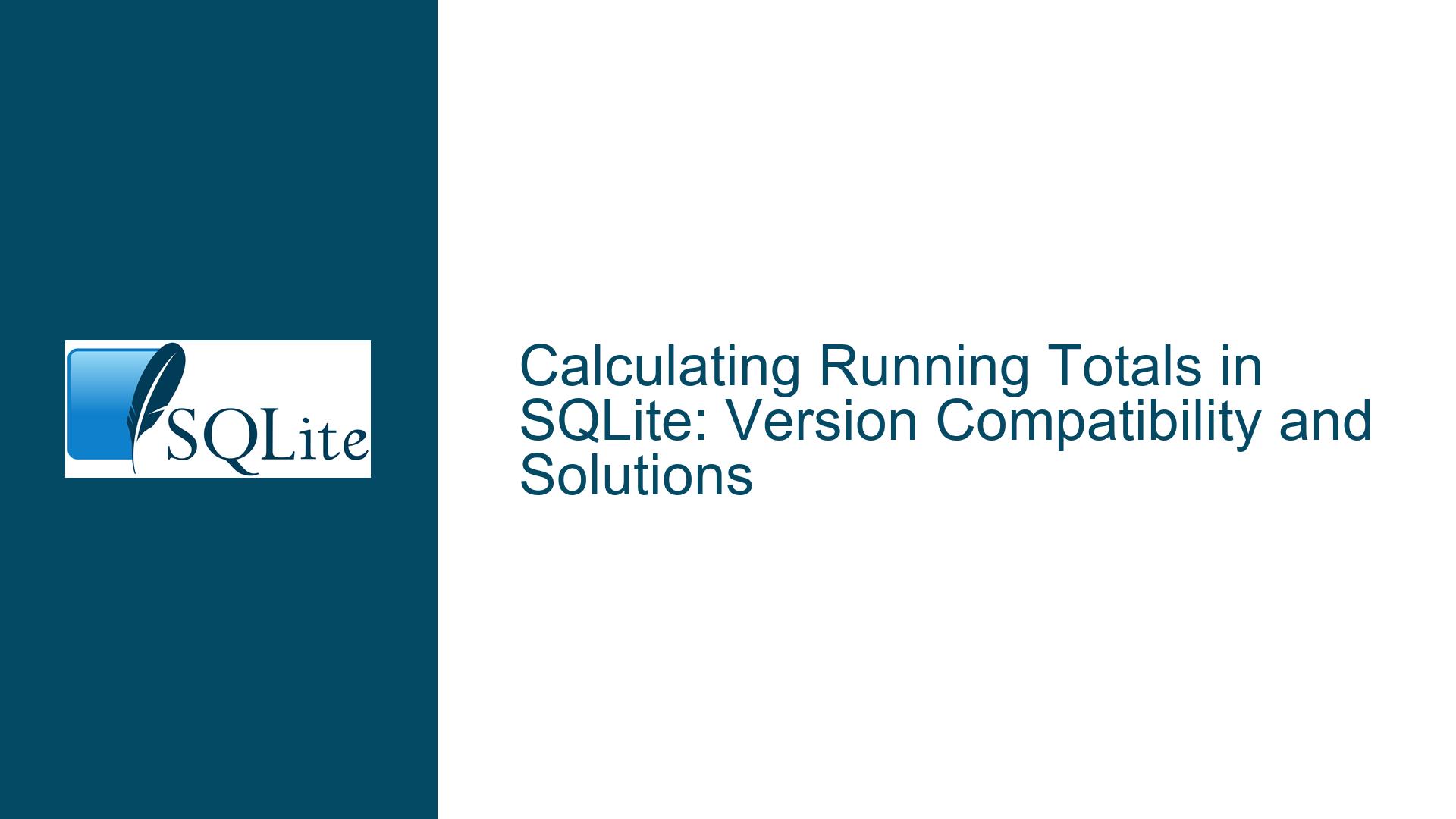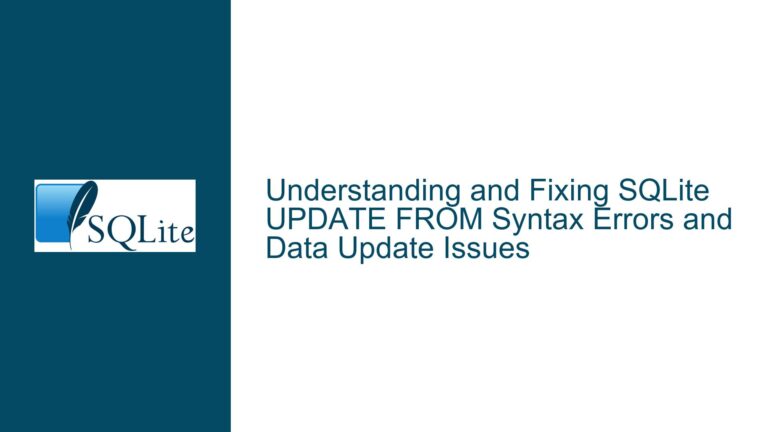Calculating Running Totals in SQLite: Version Compatibility and Solutions
Running Total Calculation Failing in SQLite 3.2
The core issue revolves around the inability to calculate a running total in SQLite version 3.2. The user is attempting to compute a running total for a column named RT, which is derived from the difference between two other columns, qtydel and qtyrec. The SQL query provided by the user includes the use of window functions, specifically the SUM() OVER(ROWS UNBOUNDED PRECEDING) syntax, which is intended to calculate the running total. However, the query fails to execute as expected, leading to the conclusion that the issue is related to the version of SQLite being used.
The user’s query is structured as follows:
SELECT
qtydel,
qtyrec,
(qtydel - qtyrec) AS RT,
SUM(RT) OVER(ROWS UNBOUNDED PRECEDING) AS NoOfCyl
FROM
your_table;
This query is designed to calculate the running total of the RT column, which is the cumulative sum of the differences between qtydel and qtyrec. However, the query does not work in SQLite 3.2, and the user is seeking a solution to this problem.
Window Functions Unavailable in SQLite 3.2
The primary cause of the issue is the absence of window functions in SQLite 3.2. Window functions, such as SUM() OVER(), were introduced in SQLite version 3.28.0. These functions allow for advanced calculations over a set of table rows that are related to the current row, making them ideal for tasks like calculating running totals, moving averages, and cumulative sums. In SQLite 3.2, these functions are not available, which means that any query attempting to use them will fail.
The user’s query relies heavily on the SUM() OVER(ROWS UNBOUNDED PRECEDING) syntax, which is a window function. Since SQLite 3.2 does not support window functions, the query cannot be executed as written. This limitation is a significant barrier to achieving the desired result of calculating a running total.
Another potential cause of the issue is the use of the COALESCE function in conjunction with the window function. While COALESCE is a standard SQL function that returns the first non-null value in a list of arguments, its use in this context may further complicate the query, especially when combined with unsupported window functions. However, the primary issue remains the lack of window function support in SQLite 3.2.
Upgrading SQLite and Alternative Solutions for Running Totals
The most straightforward solution to this problem is to upgrade SQLite to a version that supports window functions. As of the time of writing, the latest stable version of SQLite is 3.33.0, which includes full support for window functions. Upgrading to this version or any version after 3.28.0 will allow the user to execute the query as intended.
To upgrade SQLite on a Windows 7 system, follow these steps:
Download the Latest Version: Visit the official SQLite downloads page and select the appropriate precompiled binary for Windows. This will typically be a ZIP file containing the SQLite3 executable and DLL files.
Replace the Existing SQLite Installation: Extract the contents of the ZIP file to a directory of your choice. If you have an existing SQLite installation, replace the old SQLite3 executable and DLL files with the new ones. Ensure that the directory containing the SQLite3 executable is included in your system’s PATH environment variable.
Verify the Upgrade: Open a command prompt and run the command
sqlite3 --version. This should display the version number of the newly installed SQLite, confirming that the upgrade was successful.
Once the upgrade is complete, the user’s original query should work without any modifications. The window function SUM() OVER(ROWS UNBOUNDED PRECEDING) will be available, allowing the running total to be calculated as intended.
However, if upgrading SQLite is not an option, there are alternative methods to calculate a running total in SQLite 3.2. One such method involves using a correlated subquery to achieve the same result. While this approach is less efficient than using window functions, it can be used as a workaround in older versions of SQLite.
Here is an example of how to calculate a running total using a correlated subquery:
SELECT
qtydel,
qtyrec,
(qtydel - qtyrec) AS RT,
(SELECT SUM(qtydel - qtyrec)
FROM your_table t2
WHERE t2.rowid <= t1.rowid) AS NoOfCyl
FROM
your_table t1;
In this query, the correlated subquery (SELECT SUM(qtydel - qtyrec) FROM your_table t2 WHERE t2.rowid <= t1.rowid) calculates the running total by summing the differences between qtydel and qtyrec for all rows up to and including the current row. This approach mimics the behavior of the window function SUM() OVER(ROWS UNBOUNDED PRECEDING) and can be used in SQLite 3.2.
Another alternative is to use a temporary table to store intermediate results and then calculate the running total in a separate query. This method involves two steps:
- Create a Temporary Table: First, create a temporary table that stores the calculated RT values.
CREATE TEMPORARY TABLE temp_table AS
SELECT
rowid,
(qtydel - qtyrec) AS RT
FROM
your_table;
- Calculate the Running Total: Next, use a correlated subquery to calculate the running total from the temporary table.
SELECT
rowid,
RT,
(SELECT SUM(RT)
FROM temp_table t2
WHERE t2.rowid <= t1.rowid) AS NoOfCyl
FROM
temp_table t1;
This method is more cumbersome than using window functions but can be effective in environments where upgrading SQLite is not feasible.
In conclusion, the inability to calculate a running total in SQLite 3.2 is primarily due to the lack of support for window functions. The most effective solution is to upgrade to a newer version of SQLite that supports these functions. However, if upgrading is not an option, alternative methods such as correlated subqueries or temporary tables can be used to achieve the same result. Each of these methods has its own trade-offs in terms of complexity and performance, so the choice of method will depend on the specific requirements and constraints of the user’s environment.






